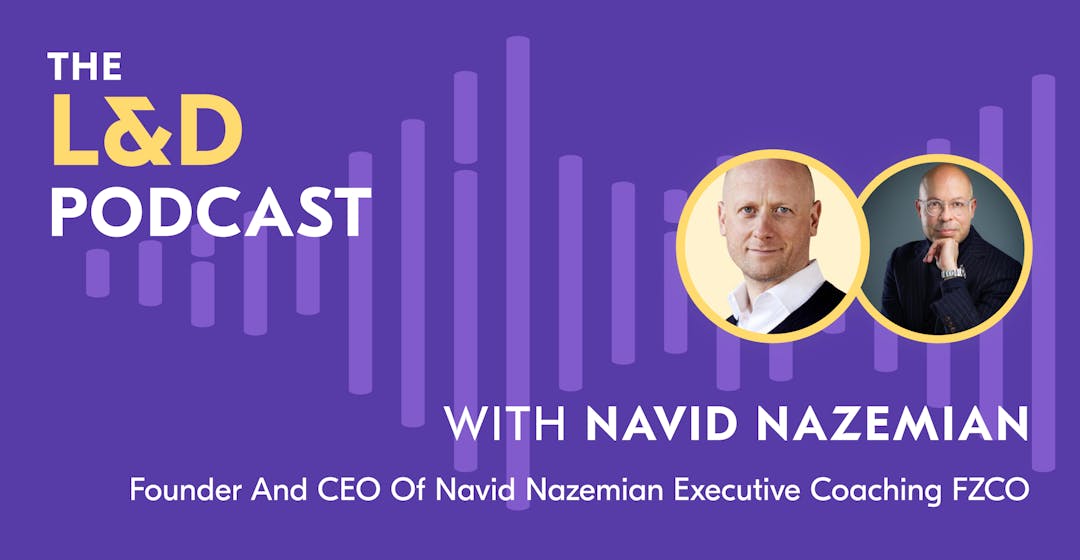
Reducing C-Suite Attrition: Supporting Executive Transitions with Navid Nazemian
Here’s an eye-watering stat: about 40% of executives fail during their transition in the first 18 months. Surprised?
What will surprise you more is the cost of these failed transitions, not only to your organization's balance sheet but to our leaders' well-being and professional growth.
So, what can L&D leaders do to ensure a more successful executive transition?
In this podcast episode, I speak with Navid Nazemian, award-winning executive coach and author of Masting Executive Transitions: The Definitive Guide, about his research into the staggering statistics of executive transitions and how learning and development can make an impact on C-suite attrition rates.
Read on to hear why so many new executives fail during their transitions, the four common challenges driving these attrition rates, and common pitfalls to avoid when supporting new leadership as they transition into your organization.
First up, Navid unpacks the research and statistics that form the foundation of his book.
40% of executive transitions fail
When Navid started researching his book, he could not believe that 40% of executive transitions fail within the first 18 months.
“I found four different studies that all came to the same conclusion, and of the four, the most validated one was published by Heidrick & Struggles,” he explains. “They looked at over 20,000 executive placements they made throughout a 10-year period, and 40% of those were not in the role anymore 18 months into the appointment.”
More importantly, these high C-suite attrition rates come at a significant cost for organizations. When working at Adidas 20 years ago, Navid led a project on attrition, and he found that the cost was about two-and-a-half times the individual's salary.
“Unfortunately,” he explains, “at the executive level, the attrition cost factor is more like 10 to 30 times the executive’s salary. You have the cost of hiring people and people coming in but not performing. A ripple effect is created when people are not doing what they should.”
So, what’s going wrong for executives that creates such a high failure rate?
The million-dollar question: what’s going wrong?
In his book, Navid dives into the top 10 reasons for high C-suite attrition rates, and these can be categorized under the group reasons of people, politics, and culture.
“It's rare that you hire a chief financial officer who isn’t good at managing the balance sheet. Hiring a chief people officer who isn't good at managing the people agenda is exceptionally rare. So, it's not the technical skills that often get in the way, but their soft skills: the ingredient for success for any leader,” he explains.
In Navid’s experience, a prominent issue at the very top is what he calls the advice trap. When working with C-suite leaders, he conducts 360-type qualitative interviews on their behalf with their peers, board members, the chairperson, and so on.
It's not the technical skills that often get in the way, but their soft skills: the ingredient for success for any leader.
“What is fascinating is when I ask straightforward questions, such as what do you think are the biggest challenges that the CEO is facing, you get a very different idea around what is crucial to the organization's mission and the expected level of performance of that individual.”
For example, Navid gets advice from board members that range from the CEO challenging their peers and the organization, following the playbook, or going for the quick wins as soon as possible and making them visible.
“So, you see how supposedly the same board of directors can have very different viewpoints around what the CEO should or shouldn't be doing. And that is part of the contradictory kind of advice that I described in my book,” he says.
Ramping up new executive performance
When it comes to how long a new executive takes to settle into their new role or organization, Navid finds that there are three factors to consider.
“First is that the average tenure for executives has been getting shorter and shorter. If you look at the S&P 500 and their CEOs, their tenures are down to 5.9 years on average,” he explains. “And one out of seven don't get to celebrate their third anniversary.”
The second factor, the Double Diamond Framework© Navid introduced in his book, considers the crucial transition period between 12 to 18 months. “That is the more realistic timeframe that applies to the C-suite and maybe even the layer below,” he says.
The average tenure for executives has been getting shorter and shorter. If you look at the S&P 500 and their CEOs, their tenures are down to 5.9 years on average. And one out of seven don't get to celebrate their third anniversary.
And the third factor, which Navid calls time to productivity, is that if you are hired at a C-suite level, a large amount of investment has gone into you. Moreso, in the first couple of months, you are learning and trying to understand how the organization works, what the culture is all about, and which aspects of that culture you want to keep and change.
“And so that timeframe is between three to nine months, and there are methods to reduce that timeframe by 50% or more,” he says.
But once new executives are in their new roles, what are the challenges that they are facing?
4 common challenges that new executives face
In Navid’s experience, new executives can face multiple challenges in the same appointment.
“Imagine if this is a burger with five patties in it, and you're not allowed to use your cutlery,” he explains. “Good luck trying to eat that because it becomes inedible.”
Navid uses his appointment at pharmaceutical company, Roche, as an example of the challenges he and similarly other new executives face in a c-suite role.
1. The big promotion
The first challenge that Navid had to deal with was his big promotion challenge.
“Why? Because I had never done a global role before and all the tricks of the trade that I applied into my regional role couldn't quite cut it for that new position,” he says. “So, I was suddenly confronted with a new reality.”
2. A new organization
Navid's second challenge was that he had never worked in the pharmaceutical sector before, and Roche as an organization was new to him.
3. Corporate diplomacy
Next is company politics, or what Navid calls the corporate diplomacy challenge.
“I was based at the global head office, and if you work in a country operation or a regional organization and suddenly move into the global head office, the reality is that there's a lot more politics at play at that level of the organization,” he says.
4. A new role
Another challenge Navid faced was that the role was brand new.
“So, they had created this role and head hunted me into it, which also meant that, particularly in the first three months, I was treading over other people's responsibility areas. And you can imagine how delighted they were about that,” he says,
“And so you see how one single appointment can include a stacking of multiple unique challenges,” Navid says. “And chances are the more challenges you face at the same time, the more the likelihood that you may not make it and fail as a result.”
Pitfalls to avoid when supporting new executives
Navid has found that organizations can do much more to support their executives in transition.
“I think the pitfall many of these organizations are falling into is that they get onboarding right for almost everyone. If you look at basic onboarding, somewhere between 85% and 88% of companies get those right,” he explains.
“But as soon as you start to move into what I call higher value activities that serve the executive level leadership, the numbers start to drop between 29% and 52%,” says Navid. “So one solution is aligning expectations with the line manager and the direct reports.”
Secondly, Navid finds that organizing meaningful meetings with key stakeholders is crucial. “Someone in L&D should be looking at the entire C-suite and mapping the critical stakeholders per position. That is currently only performed well by 33% of the organizations in the study.”
Someone in L&D should be looking at the entire C-suite and mapping the critical stakeholders per position. That is currently only performed well by 33% of the organizations in the study.
And thirdly, facilitating cultural familiarization must be on the value chain. However, very few organizations have articulated well what their culture is all about. So, Navid uses the executive assimilation process when working on behalf of his coaching clients.
“We go around and ask questions, and try to understand what makes a great leader at the organization, what the established organizational culture is, and what landmines you better avoid.”
“In my book, I speak about earning the right to bring about change to organizational culture. If you are too quick, people will not buy in because they will think you are doing a disservice to the established history and norm of the company. And if you wait for too long, people will say, ‘But you have been fine with everything for the last two years.’”

What's company culture without L&D?
By providing your contact info, you agree to receive communications from 360Learning. You can opt-out at any time. For details, refer to our Privacy Policy.
How L&D can impact new executive transition
So when it comes to you and your team helping new executives transition into their new roles, Navid has two tips to get you started.
1. Apply an executive-level appropriate framework
Firstly, Navid finds that you must apply an executive-level appropriate framework when working with that leader.
“I have introduced to the world the Double Diamond Framework of executive transitions, which lasts between 12 to 18 months,” he explains. “But whatever coach you bring in, please make sure you don't just bring in a leadership development coach.”
Navids uses the following analogy to hammer his point: if he had a heart issue, the last person he would want to see is his GP, as much as he loves the gentleman, because he would really like to see a cardiologist–someone deeply specialized in the issue.
2. Reverse the imbalance of investment
Next, Navid would like to see one or two more percent of the roughly $360 billion spent on learning and development invested in the most senior hires.
According to a study by Russell Reynolds, 90% of the cost of executive transition is spent on their assessment, selection, and recruiting process. Still, less than 10% is spent on making them successful once hired.
“So, provide the C-suite and maybe the level below with an executive transition coach because we know this is working,” he says.
Thanks to Navid for sharing his insights and experience with us! Keen to learn more from L&D experts? Check out our episode with Donald Clark about the future of corporate learning and the transformative potential of generative AI or how Peter Sheppard is improving skills by understanding the context in which they are employed.
Want more peer insights on transforming workplace learning? Sign up to become a member of the L&D Collective, and check out our other #CLOConnect interviews with top L&D leaders on driving growth and scaling culture through Collaborative Learning. Or you can subscribe (below 👇) to our weekly newsletter to receive our latest posts directly in your inbox.

